- grandMA3 User Manual
- About the manual
- Device Overview
- grandMA3 consoles
- grandMA3 full-size
- grandMA3 full-size CRV
- grandMA3 light
- grandMA3 light CRV
- grandMA3 compact XT
- grandMA3 compact
- grandMA3 extension
- grandMA3 replay unit
- grandMA3 processing units
- grandMA3 Nodes
- grandMA3 Nodes DIN-Rail
- grandMA3 I/O Node
- grandMA3 I/O Node DIN-Rail
- grandMA3 onPC command wing XT
- grandMA3 onPC command wing
- grandMA3 onPC fader wing
- grandMA3 onPC rack-unit
- Screen allocation
- Keyboard shortcuts
- Keys
- . [Dot]
- <<< [GoFastBackward] | Black
- >>> [GoFastForward] | Flash
- - [Minus]
- + [Plus]
- / [Slash] | * [Asterisk/Multiply]
- At
- Assign
- Align
- Blind
- Clear
- Channel
- Copy
- Ctrl
- Cue
- Down
- Delete
- Esc
- Edit
- Freeze
- Full
- Fixture
- Group
- Goto
- Go+ [large]
- Go- [large]
- Go+ | Temp
- Go- | Top
- Help
- Highlt [Highlight]
- If
- Learn | Rate1
- List
- MA
- Menu
- Move
- Next
- Numeric keys | arrows
- Oops
- On
- Off
- Pause [large]
- Pause | Fix
- Page+
- Page-
- Please
- Power
- Preset
- Prvw [Preview]
- Prev [Previous]
- Select
- SelFix [SelectFixture]
- Sequ [Sequence]
- Set
- Solo
- Stomp
- Store
- Thru
- Time
- Up
- Update
- U1
- U2
- X1 | Clone
- X2 | Link
- X3 | Grid
- X4 | Layout
- X5 | Step
- X6 | TC
- X7 | View
- X8 | DMX
- X9
- X10
- X11
- X12
- X13 | Phaser
- X14 | Macro
- X15 | Page
- X16 | Exec
- Xkeys
- Control elements
- Command area
- Master area
- Custom area
- Dual encoders
- Level wheel
- Grand master
- Executor elements
- Connector pin assignment
- UPS battery
- grandMA3 consoles
- System Overview
- Standalone device
- Locally networked devices
- World server
- Parameters
- Calculate parameters
- Expand the amount of parameters
- First Steps
- Unpack the device
- Check scope of delivery
- Position the device
- Connect power
- Connect desk light
- Connect external screens
- Connect USB devices
- Connect DMX
- Connect Audio In
- Connect MIDI
- Connect LTC
- Connect Ethernet
- Connect DC Remote In
- Connect grandMA3 extension
- Connect grandMA3 fader wing
- Turn on the device the first time
- grandMA3 onPC
- System requirements grandMA3 onPC
- Windows installation
- Optimize Windows
- macOS installation
- Optimize macOS
- onPC Terminal App
- onPC settings
- Show File Handling
- Workspace
- User interface
- Configuration of displays
- Desk lock
- User-defined area
- Command line
- Control bar
- View bar
- Tables in general
- Trackpad window
- Gestures
- Command area
- Master controls
- Playback controls
- Displays in grandMA3 onPC
- Encoder bar
- Feature group control bar
- Encoder toolbar
- Calculator
- Playback bar
- Command wing bar
- Colors
- System
- Markers
- Color theme
- User interface
- Command Syntax and Keywords
- General syntax rules
- General keywords
- ; [Semicolon]
- / [Slash]
- . [Dot]
- .. [DotDot]
- = [Equal]
- <<< [GoFastBackward]
- >>> [GoFastForward]
- - [Minus]
- * [Asterisk]
- % [Percent]
- + [Plus]
- Absolute
- Acceleration
- Action
- ActivationGroup
- Agenda
- Align
- AlignTransition
- Appearance
- Assign
- At
- Attribute
- AutoCreate
- Black
- Blind
- Block
- BPM
- Call
- Camera
- Capture
- ChangeDestination
- Channel
- ChannelSet
- Chat
- ChatJoin
- ChatLeave
- Cleanup
- Clear
- ClearActive
- ClearAll
- ClearSelection
- Clone
- CommandDelay
- Collect
- Collection
- Color
- ColorDef
- ColorTheme
- Configuration
- Console
- Cook
- Copy
- Cue
- CueAbs
- CueDelay
- CueFade
- CueInDelay
- CueInFade
- CueOutDelay
- CueOutFade
- CueRel
- CueUpdate
- CurrentEnvironment
- CurrentUser
- CurrentUserProfile
- Cut
- DataPool
- Deceleration
- Decimal8
- Decimal16
- Decimal24
- Default
- Delay
- Delete
- DeleteOtherVersions
- DelGlobalVar
- DelUserVar
- Dismiss
- Display
- DMXLayer
- DMXAddress
- DMXReadout
- DMXUniverse
- DoubleSpeed
- Down
- DumpLog
- Drive
- Echo
- Edit
- EditSetting
- Eject
- Effect
- EndIf
- Environment
- Exchange
- Executor
- Export
- Extract
- Extension
- Fade
- Fader
- FaderMaster
- FaderRate
- FaderSpeed
- FaderTemp
- FaderTime
- FaderX
- FaderXA
- FaderXB
- FeatureGroup
- Filter
- Fix
- FixtureClass
- FixtureLayer
- Fixture
- FixtureType
- Flip
- Flash
- Fog
- Font
- Freeze
- Full
- Gel
- GetGlobalVar
- GetUserVar
- Go+
- Go-
- Goto
- Grid
- GridPos
- Group
- HalfSpeed
- HardwareKey
- Help
- Helplua
- Hex8
- Hex16
- Hex24
- Highlight
- Houselights
- Hz
- If
- IfActive
- IfOutput
- IfProg
- Image
- Import
- Index
- Insert
- Integrate
- Interface
- Invert
- Invite
- IP
- JoinSession
- Key
- Keyboard
- KeyboardShortcuts
- Knockin
- Knockout
- Label
- Language
- Layout
- LearnSpeed
- LeaveSession
- Library
- List
- ListOwner
- ListRef
- Load
- Loaded
- LoadShow
- Lock
- Login
- Logout
- Lowlight
- Lua
- LuaFile
- Macro
- MArker
- Master
- MAtricks
- Measure
- Media
- MemInfo
- Menu
- Mesh
- MessageCenter
- Monitor
- Move
- Multipatch
- MyRunningMacro
- MyRunningPreset
- MyRunningSequence
- Natural
- NDI
- NewShow
- NextY
- NextZ
- Next
- Node
- NonDim
- Normal
- Off
- Offset
- On
- onPC
- OSC
- Oops
- OutputLayer
- Page
- Part
- Park
- Paste
- Patch
- Pause
- Percent
- PercentFine
- Phase
- Physical
- Plugin
- Preset
- PresetUpdate
- Press
- Preview
- PreviousY
- PreviousZ
- Previous
- Programmer
- Property
- PU
- Pyro
- Rate1
- RDM
- Readout
- Reboot
- Recast
- Record
- Relation
- Relative
- Release
- ReloadPlugins
- ReloadUI
- Remote
- RemoteHID
- RemoteCommand
- Remove
- RenderQuality
- Reset
- Restart
- Root
- RTChannel
- RunningMacro
- RunningPreset
- RunningSequence
- RunningTimecode
- SaveShow
- ScreenConfig
- ScreenContent
- Scribble
- Seconds
- Select
- Selection
- SelFix
- Sequence
- SendMIDI
- SendOSC
- Set
- SetGlobalVar
- SetUserVar
- Shuffle
- Shutdown
- SnapDelay
- SoftwareImport
- SoftwareUpdate
- SoundChannel
- Solo
- SpecialExecutor
- Speed
- Speed1
- Stage
- Station
- Step
- Stomp
- SwitchGma2Mode
- Swop
- Store
- Temp
- Texture
- Thru
- Time
- Timecode
- TimecodeSlot
- Toggle
- TopUp
- Top
- Transition
- Type
- UIChannel
- UIGridSelection
- UnBlock
- Universal
- UnLock
- UnPark
- UnPress
- Up
- Update
- UpdateContent
- User1
- User2
- User
- UserProfile
- Video
- Version
- View
- ViewButton
- Width
- World
- Xkeys
- Zero
- Option keywords
- /Active
- /ActiveForSelected
- /AddNewContent
- /All
- /AllForSelected
- /Ask
- /Auto
- /CopyCueDst
- /CopyCueScr
- /CreateReferenceObject
- /CreateSecondCue
- /CueOnly
- /Date
- /Default
- /DiscardChanges
- /DMX
- /Embed
- /Enumerate
- /File
- /ForceGlobal
- /GDTF
- /Gaps
- /Global
- /GridMergeMode
- /Indirect
- /KeepActivation
- /Look
- /Merge
- /NoConfirm
- /OriginalContentOnly
- /Overwrite
- /Path
- /Release
- /Remove
- /Screen
- /Selective
- /Universal
- Extended command line syntax options
- Windows, Views, and Menus
- Add window
- Rearrange
- Store and recall views
- Remove windows from a screen
- Window settings
- Menus
- Change menu locations
- Pool windows
- Create pool object
- Label pool objects
- Move pool objects
- Insert pool objects
- Copy pool objects
- Lock and unlock pool objects
- Delete pool objects
- Networking
- Interfaces and IP
- Session
- Create a session
- Join a session
- Leave a session
- Invite to a session
- Dismiss from session
- Create a custom key
- Session master selection
- Web remote
- DMX In and Out
- DMX port configuration
- Ethernet DMX
- Art-Net menu
- sACN menu
- Transmit DMX using Art-Net
- Single User and Multi User Systems
- Create User
- User settings
- Patch and Fixture Setup
- What are fixtures
- Add fixtures to the show
- Add multipatch fixtures
- MVR
- Live patch
- DMX sheet
- DMX universes
- Remove fixtures from the show
- Position fixtures in the 3D space
- 3D
- Camera Pool
- Stages
- Classes and Layers
- Attribute definitions
- Activation group
- Feature group
- Deactivation group
- Parameter list
- DMX curves
- Operate Fixtures
- Select Fixtures
- What is the programmer
- Fixture sheet
- Encoder resolution
- Using the color picker
- Gel pool
- Selection bar
- Align
- Selection Grid
- Smart view
- General parent.child structure
- Scribbles
- Create scribbles
- Edit scribbles
- Assign scribbles
- Delete scribbles
- Images
- Screenshots
- Video
- Appearances
- Create appearances
- Use appearances
- Delete appearances
- Groups
- Create groups
- Edit groups
- Delete groups
- Group masters
- Presets
- Preset pools
- Create new presets
- Recipe presets
- Use preset
- Edit or Update presets
- Worlds and Filters
- At filter
- Create a world
- Create a filter
- Use a world or filter
- Delete a world
- Delete a filter
- MAtricks and Shuffle
- Blocks
- Groups
- Wings
- Widths
- Shuffle
- Transform
- Cues and Sequences
- What is tracking
- Sequences sheet
- Content sheet
- Sequence settings
- Store cues
- Update cues
- Copy cues
- Cue recipes
- Store settings and preferences
- Play back cues
- Move in black
- Cue timing
- Renumber cues
- Delete cues
- Executors
- Assign object to an executor
- Executor configurations
- Running playbacks
- Special executors
- Masters
- Selected masters
- Grand masters
- Time Control
- Speed masters
- Playback masters
- Recipes
- Phasers
- Phaser editor
- Create sinus dimmer phaser
- Create circle phaser
- Create circle phaser around position
- Create color rainbow phaser
- XYZ
- Activating XYZ for fixture types
- MArker fixture
- Macros
- Create macros
- Edit macros
- Assign macros to keys and buttons
- Variables
- Examples
- Agenda
- View modes
- Create an agenda entry
- Edit an agenda entry
- Agenda toolbar
- Timecode
- What are timecode slots
- Timecode settings
- Track groups
- Time ranges and events
- Toggle view mode
- Record a timecode show
- Record an external timecode show
- Edit a timecode show
- Layouts
- Create a layout
- Assign multipatch fixtures
- Edit layout
- Layout view settings
- Edit layout view
- Edit layout elements
- Layout encoder bar
- Plugins
- What is Lua?
- Handle
- Functions - Object-Free API
- BuildDetails
- CloseUndo
- Cmd
- CmdIndirect
- CmdIndirectWait
- CmdObj
- Confirm
- CreateUndo
- DataPool
- DefaultDisplayPositions
- DeskLocked
- Echo
- ErrEcho
- ErrPrintf
- Export
- ExportCSV
- ExportJson
- FromAddr
- GetPath
- GetShowFileStatus
- GetSubfixture
- GetSubfixtureCount
- HandleToStr
- HandleToInt
- HookObjectChange
- HostOS
- HostSubType
- HostType
- Import
- IntToHandle
- MasterPool
- MessageBox
- ObjectList
- Patch
- PopupInput
- Printf
- ProgrammerPart
- ProgressBar
- Pult
- Root
- SelectedSequence
- Selection
- SelectionCount
- SelectionFirst
- SelectionNext
- SerialNumber
- ShowData
- StrToHandle
- ShowSettings
- TextInput
- Timer
- UserVariables
- Version
- Functions - Object API
- Addr
- AddrNative
- Children
- Dump
- Export
- HasActivePlayback
- Import
- ToAddr
- Data Pools
- System
- Date and time
- Clock
- Desk lights
- System information
- System monitor
- Info Window
- Sound
- Sound Window
- Remote In and Out
- DC remotes
- MIDI remotes
- DMX remotes
- OSC
- PSN
- MIDI
- RDM
- Control other MA Devices
- grandMA3 Nodes
- MA Network Switch
- RemoteHID
- Update the Software
- Update grandMA3 consoles
- Update grandMA3 Nodes
- Update grandMA3 onPC windows hardware
- Update grandMA3 viz-key
- Network update
- Delete update files
- Troubleshooting
- Fixture Types
- Import fixture types
- Import GDTF
- Conflicts in fixture types
- Build fixture types
- Insert fixture types
- Insert DMXModes
- Insert geometries
- Insert models
- Link models to geometries
- Link DMX modes to geometries
- Export fixture types
- Export GDTF
- Import fixture types
- File Management
- SFTP connection
- Import / Export Menu
- Folder Structure
- Shut down the System
- Troubleshooting
- Clean start
- grandMA3 Quick Start Guide
- grandMA3 Quick Manual consoles
- grandMA3 Quick Manual processing units
- grandMA3 Quick Manual Nodes
- grandMA3 Quick Manual Nodes DIN-Rail
- grandMA3 Quick Manual onPC command wing XT
- grandMA3 Quick Manual onPC command wing
- grandMA3 Quick Manual onPC fader wing
- grandMA3 Quick Manual onPC rack-unit
- grandMA3 Quick Manual viz-key
- grandMA3 Quick Manual I/O Nodes
- Release Notes
New help version
The help version you selected belongs to an older software version. You may want to view the latest help version.
OSC (Open Sound Control)
OSC is a client and server system that defines a message address pattern used to address elements in the receiving server.
The grandMA3 software supports OSC 1.1. For more information about how to format OSC packets, see https://ccrma.stanford.edu/groups/osc/spec-1_0.html.
Open Sound Control, or OSC, is a networking protocol used to allow devices of various types to control other devices of other types. OSC messages are human-readable (unlike, for example, MIDI Show Control, or MSC), and follow this general pattern:
"(/prefix)/[OSC Address],[OSC Type],[Value]"
prefix - this is optional, depending on your system setup. It can be used in a more complex OSC network to differentiate messages meant for one set of devices (e.g. lighting consoles) and not others (e.g. sound consoles).
OSC Address - this is the target you are controlling on the receiving device(s), for example /Fader201 would be the address to move the fader for executor 201 in grandMA3. Sometimes the address will be more complex, for example /Page1/Fader201 would be the address to move the fader for executor 201 on page 1 in grandMA3.
OSC Type - this is the type of value you're sending, for example:
i = integer
f = float
s = string
t = true
f = false
Value - this is the value you are actually sending for the target.
An example OSC command to set the fader for executor 201 to 100 might be:
- "/Page1/Fader201,i,100"
- or with a prefix to specify only, e.g. grandMA3 devices: "/gma3/Page1/Fader201,i,100"
For more information about the OSC address, OSC type, and OSC structure, see SendOSC keyword.
- To adjust the settings of OSC, tap OSC in the In & Out window.
The OSC settings window opens.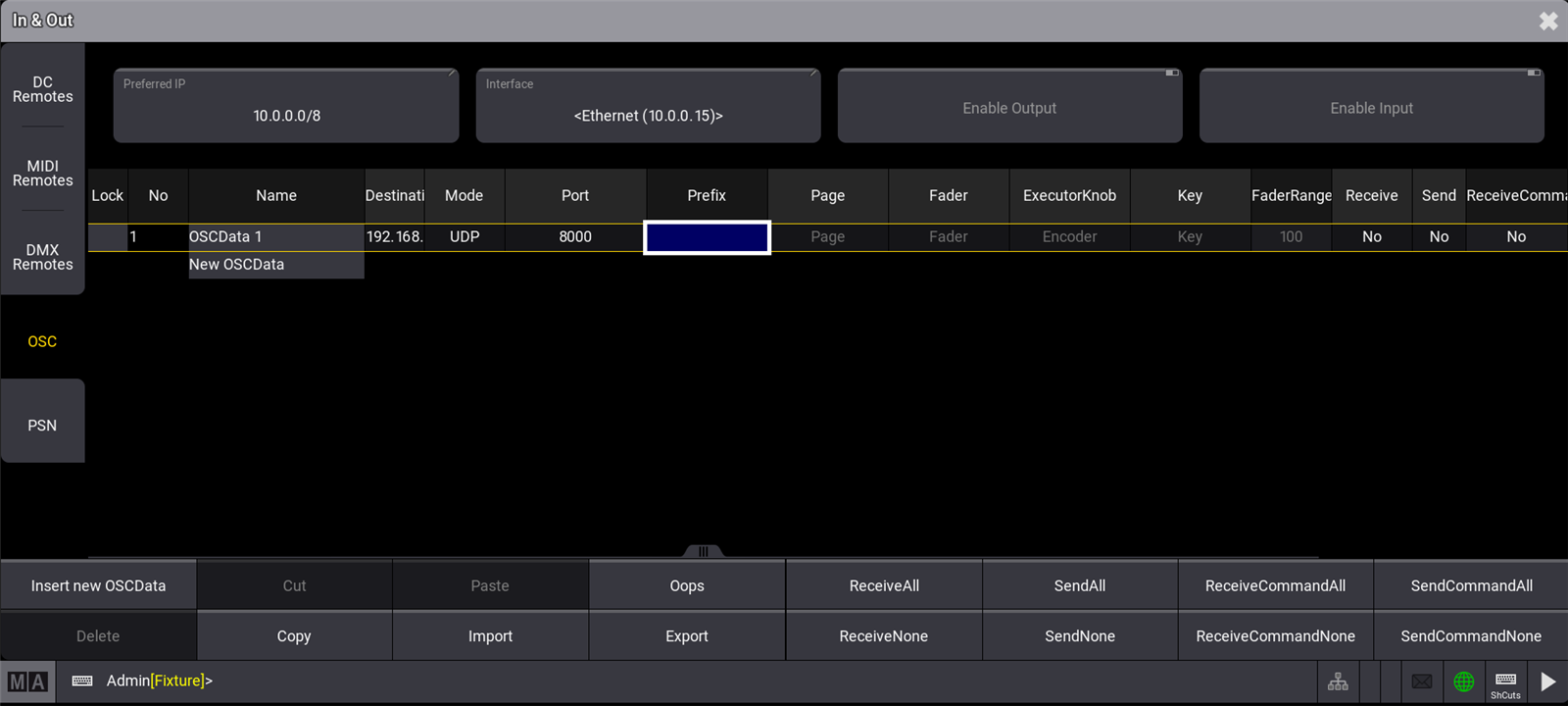
OSC settings window
Please note that in the example above, no prefix is defined.
The most important OSC setting is the correct network configuration.
Make sure that the IP address, the network protocol (UDP, TCP), and the port are set correctly.

Please note that the port configuration is used for sending and receiving OSC data.
When receiving OSC messages, Input will highlight its title bar. When sending OSC messages, the title bar of Output will be highlighted.
Each configuration line for OSC can be used for input and/or output.
These properties can be configured:
- Name: Sets the name for this configuration.
- Destination IP: Sets the IP address for sending OSC data. A specific IP address or a broadcast IP can be set.
- Mode: OSC packets can be sent via UDP or TCP.
- Port: Specifies the network port of the incoming and/or outgoing OSC packets.
- Prefix: A prefix can be set by the user if he needs to. A prefix can be used for example as a criterion for limiting the range of possible receivers, e.g. /lighting would only take packets with /lighting into account, and discard OSC packets with the /sound-prefix.
- Page: Specifies which OSC Address of incoming OSC messages is routed to pages.
- Fader: Specifies which OSC Address of incoming OSC messages is routed to faders.
- ExecutorKnob: Specifies which OSC Address of incoming OSC messages is routed to the mini encoders.
- Key: Specifies which OSC Address of incoming OSC messages is routed to keys.
- FaderRange: Specifies which OSC value range is used for the fader, e.g. FaderRange 255 sets OSC 0-255 to 100%.
- Receive: Specifies if OSC data (but no commands) shall be received.
- Send: Specifies if this OSC configuration sends OSC data (but no commands).
- Receive Command: Specifies if commands for the command line will be received via OSC. This setting is independent of the general receive setting.
- Send Command: Specifies if commands of the command line will be sent via OSC. This setting is independent of the general send setting.
- EchoInput: Specifies if the input data shall be displayed in the system monitor.
- EchoOutput: Specifies if the output data shall be displayed in the system monitor.
With the buttons ReceiveAll, ReceiveNone, SendAll, SendNone, Receive CommandAll, Receive CommandNone,Send CommandAll, and Send CommandNone all OSC configuration lines can be modified together for the properties Receive, Send, Receive Command and Send Command.
The addresses defined for Page, Prefix, Fader, ExecutorKnob, and Key are case-sensitive.
In addition to the example OSC strings mentioned above, the entirety of the grandMA3 command line can be accessed via OSC, using the "/cmd" OSC Address and the string 's' OSC Type. Note - this requires "Receive Command" to be set to Yes. For example:
- "/cmd,s,FaderMaster Page 1.201 At 100"
- Bring fader 201 on page 1 to 100% (same as the examples above but using gMA3 command line syntax instead)
- "/cmd,s,Fixture 1 At 75"
- Use gMA3 command line syntax to execute the command "Fixture 1 At 75" in the command line
- "/cmd,s,Go+ Exec 402"
- Trigger whatever is assigned to exec 402
- "/cmd,s,Patch Fixture 1 3.42"
- Patch fixture 1 to address 42 in universe 3
Examples for Using OSC
Common programs to trigger grandMA3:
TouchOSC
TouchOSC is a modular OSC and MIDI control surface for Windows, macOS, and Android by hexler.net.
It supports sending and receiving Open Sound Control and MIDI messages over Wi-Fi and CoreMIDI inter-app communication and compatible hardware.
Fader
This example will control the fader on Executor 230 of Page 1:
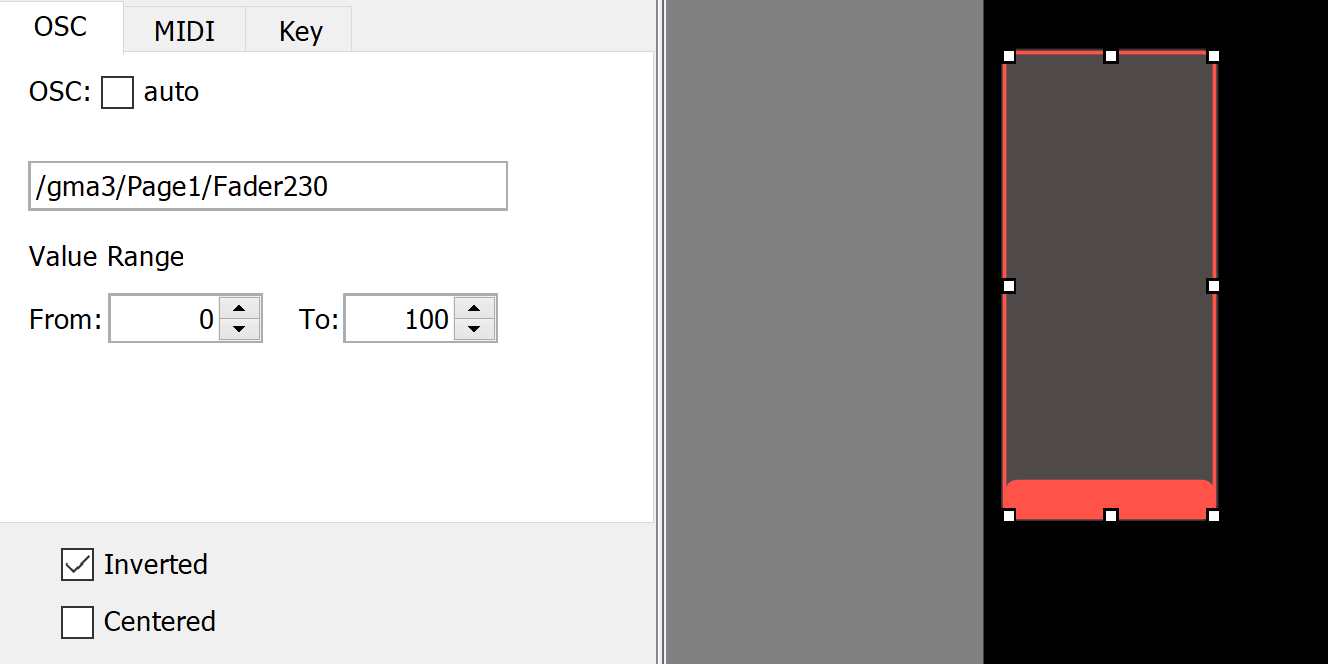
Notes:
- Assumes the OSCData line on the console has a prefix of "gma3" configured. If the prefix is empty, this would just be /Page1/Fader230.
- Assumes the "Page" and "Fader" cells in the OSCData line on the console are set to "Page" and "Fader" respectively (this is the default).
Executor button
This example will press the button for Executor 230 of Page 1:
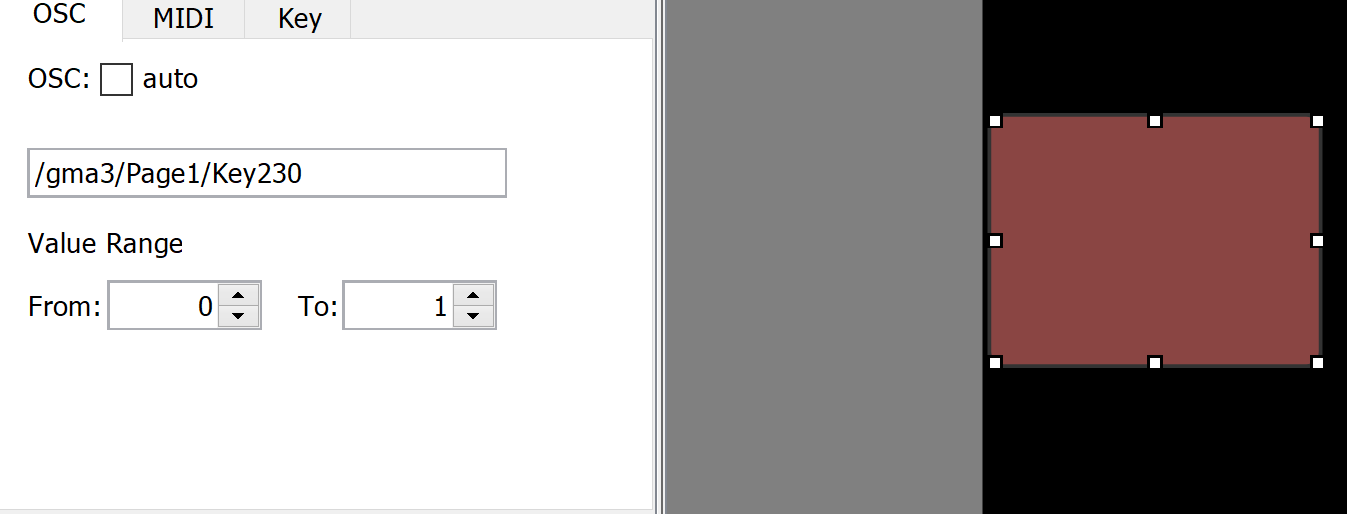
Notes:
- Assumes the OSCData line on the console has a prefix of "gma3" configured. If the prefix is empty, this would just be /Page1/Key230.
- Assumes the "Page" and "Key" cells in the OSCData line on the console are set to "Page" and "Key" respectively (this is the default).
- The {Send on Press} and {Send on Release} settings (not pictured above) should both be enabled/checked.
QLab
QLab is sound, video, and lighting control for macOS by qlab.app.
QLab is fairly simple to use with OSC. These are the QLab network settings in our example:

- Name = something to identify this particular configuration
- Network = the network interface on your computer connected to the grandMA3 system
- Destination
- IP address of the grandMA3 console
- Port set in the OSCData line configuration in the console (8000 is default)
And then we have our cue setup in QLab:
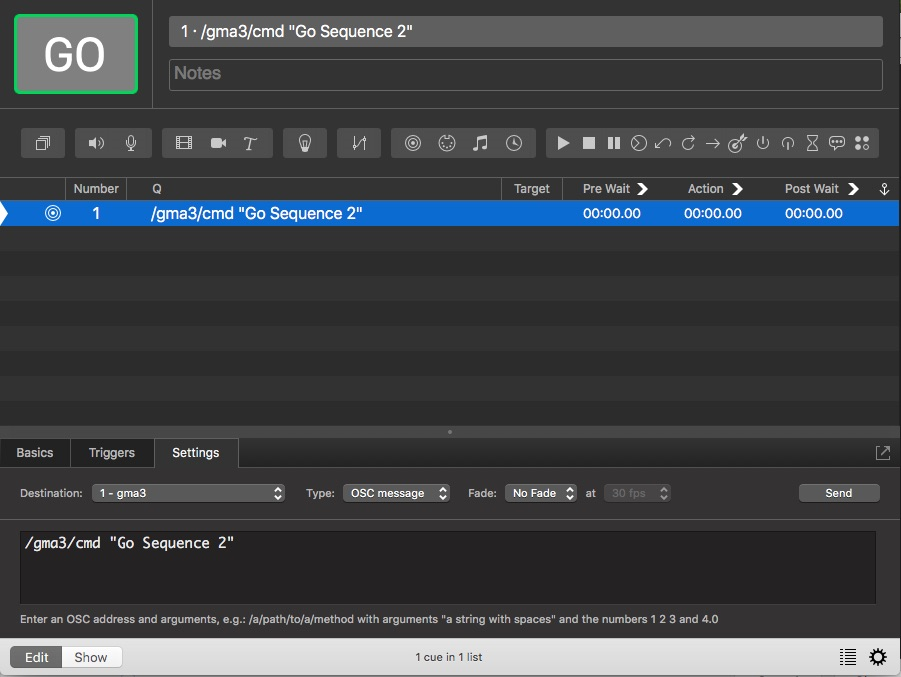
- Destination = configuration as set in the "Network Cue Destination Patches" above
- Type = OSC message
- Enter the desired OSC message
- OSCAddress - in this example we are sending a command syntax string directly, so the address is: /gma3/cmd
- This assumes the OSCData line on the console has a prefix of "gma3" configured! If the prefix is empty, this would just be /cmd
- Requires "Receive Command" to be enabled for that OSCData line on the console!
- Argument - enter the command syntax in quotes, e.g. "Go Sequence 2" (advancing to the next cue in Sequence 2)
- OSCAddress - in this example we are sending a command syntax string directly, so the address is: /gma3/cmd
Open Stage Control
Open Stage Control is a free program you can use to build a simple OSC interface. When you first open it, you'll be prompted for some network configuration settings. Besides telling it which network interface to use on the computer, the only thing to fill in here is the port:
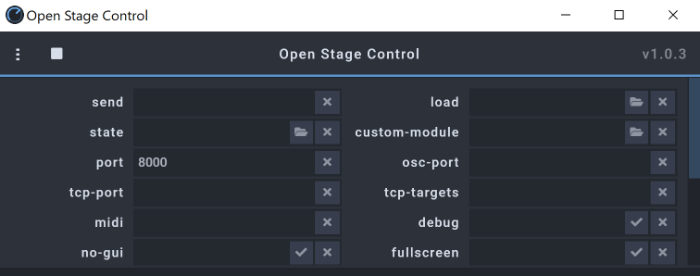
This needs to match the port you've set in the corresponding OSCData line in the console. Port 8000 is the default. Then you can start your Open Stage Control session.
Fader
This example will control the fader for Executor 230 on Page 1:
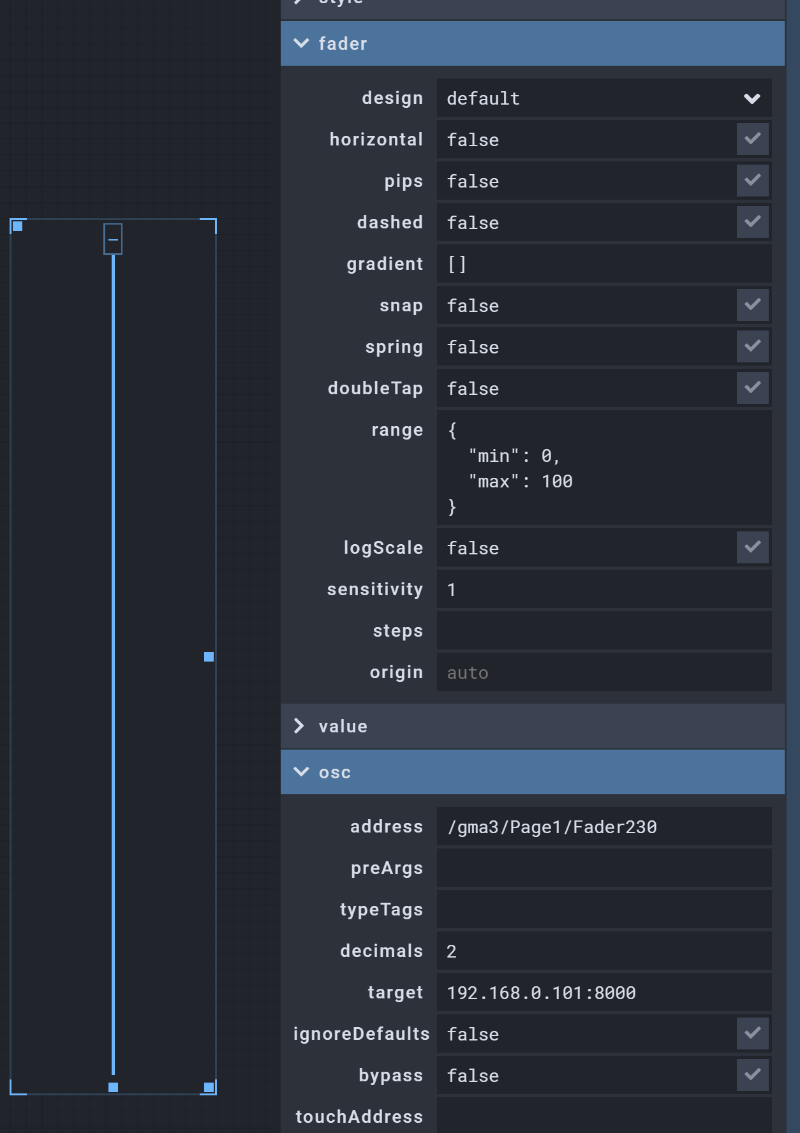
Notes:
- Assumes the OSCData line on the console has a prefix of "gma3" configured. If the prefix is empty, this would just be /Page1/Fader230.
- Assumes the "Page" and "Fader" cells on the OSCData line in the console are set to "Page" and "Fader" respectively (this is the default).
- All of the settings in the picture above are at their defaults except for:
- Fader settings: Range: change the 'max' to 100 instead of 1
- OSC settings: Address
Executor button
This example will press the button for Executor 229 on Page 1:

Notes:
- Assumes the OSCData line on the console has a prefix of "gma3" configured. If the prefix is empty, this would just be /Page1/Key229.
- Assumes the "Page" and "Key" cells in the OSCData line on the console are set to "Page" and "Key" respectively (this is the default).
- All of the settings in the picture above are at their defaults except for the address in the OSC settings
- Open Stage Control buttons default to functioning as 'toggle' - you may wish to change this to 'tap'
Command Line Syntax
Here we have a button that will execute command line syntax on the console, in this case triggering the Selected Sequence:
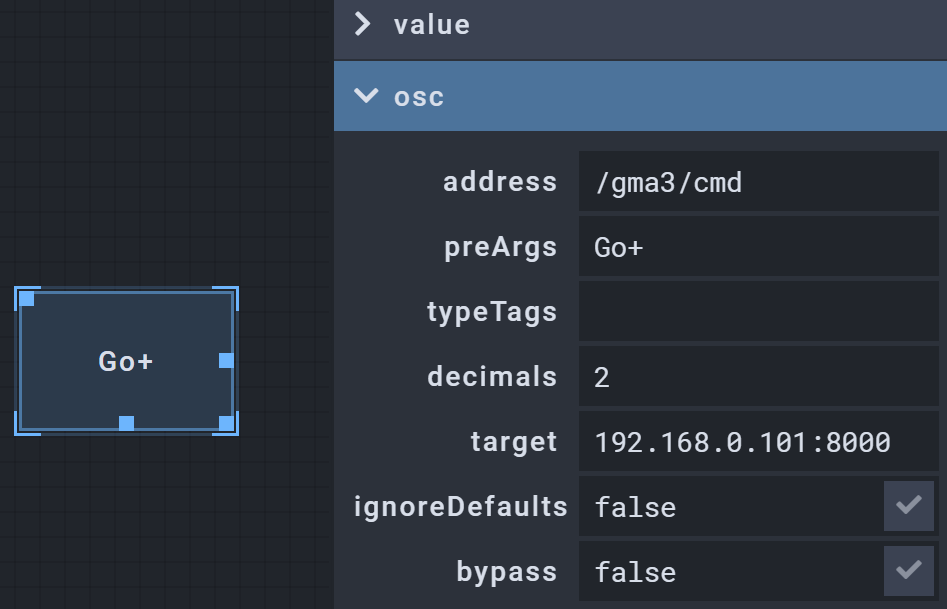
Notes:
- Assumes the OSCData line on the console has a prefix of "gma3" configured. If the prefix is empty, this would just be /cmd.
- Requires "Receive Command" to be enabled for that OSCData line on the console!
- All of the settings in the picture above are at their defaults except for:
- button mode set to "momentary"
- address
- preArgs - this is where you enter the syntax string you wish to execute


